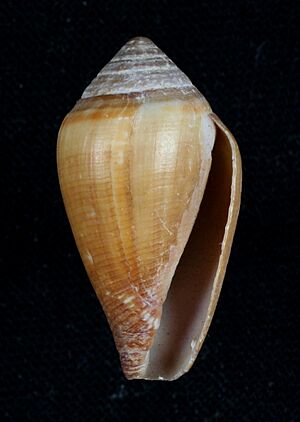Californian cone facts for kids
Quick facts for kids Californian cone |
|
|---|---|
 |
|
| A Californian cone shell, about 29 mm tall, found in Huntington Beach, California. | |
| Conservation status | |
| Scientific classification | |
| Synonyms | |
|
The Californiconus californicus, also known as the Californian cone, is a type of small, hunting sea snail. It belongs to the family called Conidae, which are known as cone snails.
As its name suggests, this special cone snail lives along the coast of California.
Contents
Where Does the Californian Cone Live?
This small cone snail is quite special because most cone snails live in warm, tropical waters. However, the Californian cone prefers the cooler, temperate waters of the eastern Pacific Ocean.
You can find it along most of the California coast. Its home stretches from the Farallon Islands near San Francisco all the way down to Bahia Magdalena in Baja California, Mexico.
What Kind of Home Does it Like?
The Californian cone lives in both rocky and sandy places. It can be found in the intertidal zone, which is the area between high and low tide. It also lives deeper underwater, down to about 30 meters (about 100 feet).
What Does the Californian Cone Look Like?
The shell of this snail is usually grayish-brown. It has a thick outer layer called a periostracum. The shell is rounded at the top, like a shoulder.
The opening of the shell, called the aperture, is wider at the bottom. The top part of the shell, called the spire, is flat on its sides. These shells usually grow to be about 25 to 40 millimeters (1 to 1.5 inches) tall.
What Does the Californian Cone Eat?
The Californian cone is a hunter! It actively searches for and eats marine worms, small fish, and other mollusks. It also acts as a scavenger, meaning it will eat dead animals it finds.
Fossil Discoveries
Scientists have found fossils of the Californiconus californicus in rocks from the Late Pleistocene period. These fossils were discovered in Isla Vista, California. This shows that these snails have been around for a very long time!
Images for kids






